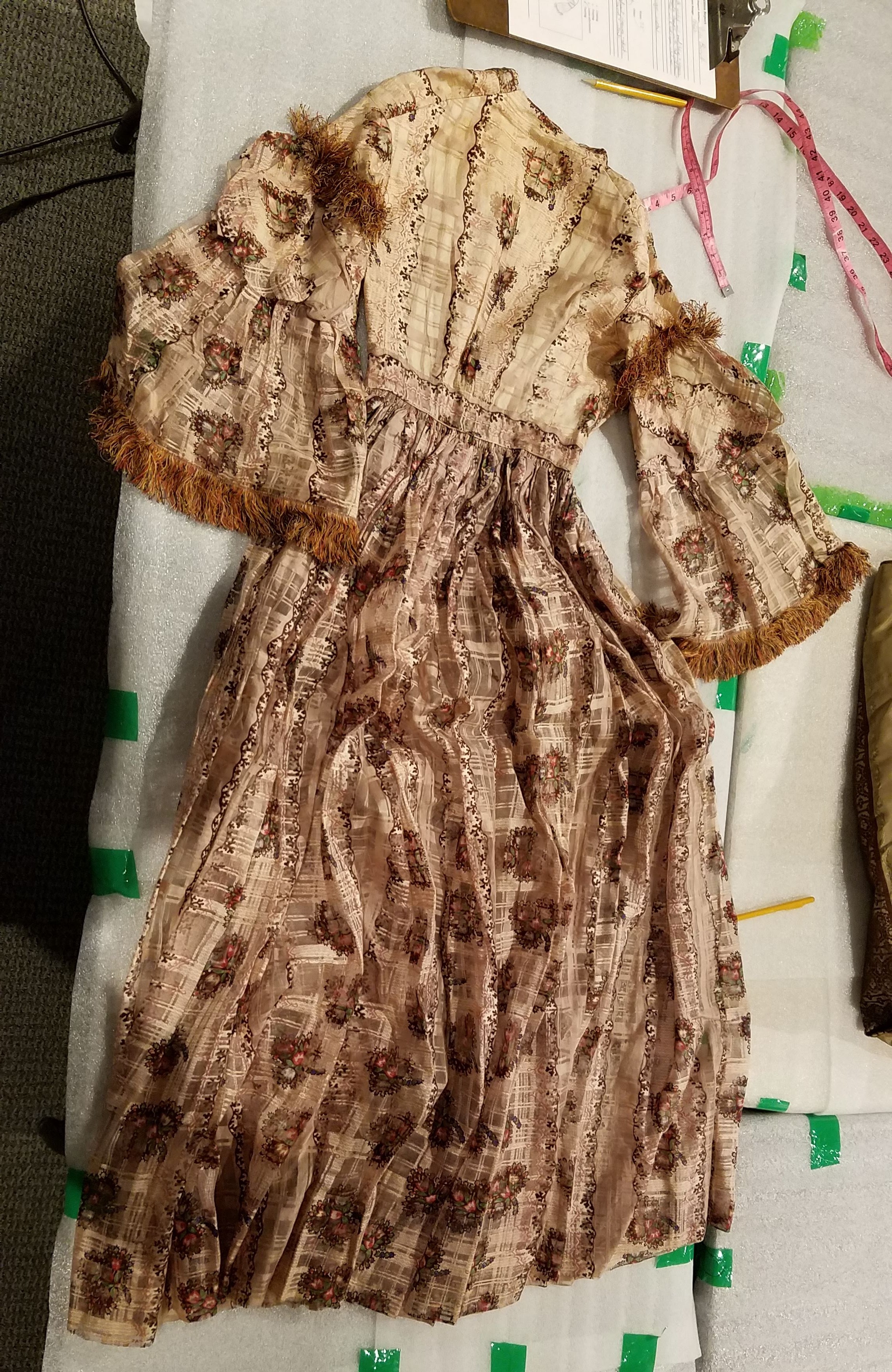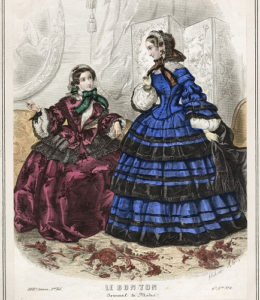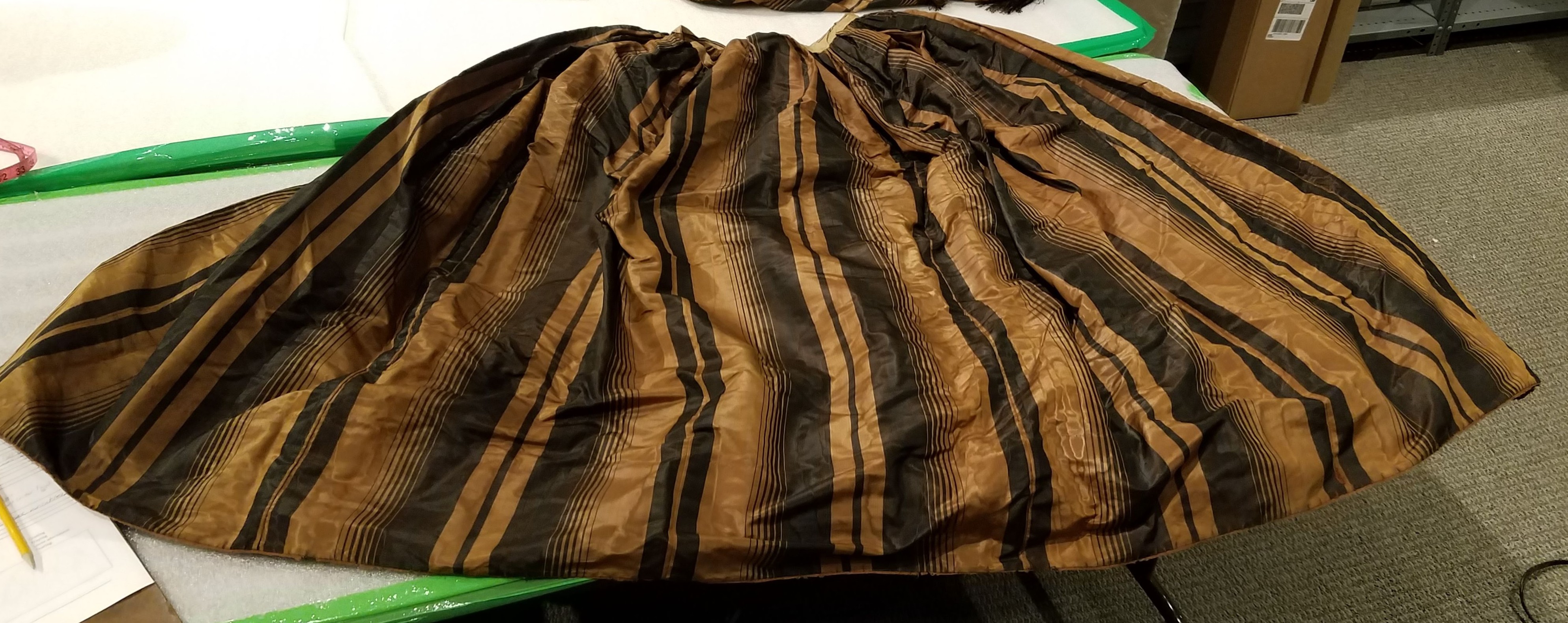Dating 101: The Pagoda Sleeve of the Mid-19th Century
By Vivien Barnett, Fashion Archives Intern 2019
This summer, I and the other Fashion Archives interns have been charged with the rediscovery, processing, and rehousing of costumes from the Maryland Historical Society’s Fashion Archives. Many of the costumes lack accompanying information about the original wearer, or even the time period, so it is necessary for us to be able to date the garments to a specific decade of fashion history. We do this by looking at the fabric from which a garment is constructed, the neckline, skirt size, waistline, type of sleeve, and other pieces of the garment. A little knowledge of fashion history can go a long way, and knowing the relative time periods in which a particular sleeve type was popular can help us to accurately date an artifact.
 |
| Maryland Historical Society, Gift of Mrs. William H. Pitcher, 1973.53.8a, Brown striped silk day dress bodice, 1857-1859, silk, metal. |
| My interest in the pagoda sleeve began when I pulled this garment from the historic Pratt House: a brown striped silk bodice and skirt with a wide, two-tiered sleeve and a decorative silk fringe trim. This was the first time I had ever seen this style of sleeve in person, and I lacked the words to describe it! However, after consulting with our supervisor in the Fashion Archives, Emily Bach, I soon learned it was called a pagoda sleeve, and that it was an incredibly popular style from approximately the 1840s to the 1860s. We determined that this day dress dates to 1857-1859 because of its basque bodice, wide pagoda sleeves, and its decorative which fringe became popular in the late 1850s. Furthermore, brown striped fabric was common in America in this decade, and its skirt had a large hem circumference, which was characteristic of this particular decade in fashion history.
|
| Maryland Historical Society, Gift of Mrs. William H. Pitcher, 1973.53.8b, Brown striped silk day dress skirt, 1857-1859, silk, metal. |
This garment inspired me to conduct some independent research into the history of this mid-19th century style. The pagoda sleeve is characterized by a narrow shoulder opening which expands to a very wide cuff, and it often has two tiers of fabric which overlap at the elbow. Wide sleeves on garments reached the height of their popularity in the year 1857, with the widespread use of surface embellishments such as fringes soon to follow. This sleeve style rapidly fell from popularity after the year 1864, which can be seen in their infrequency in appearance in fashion plates from this era. Below is another example of a late 1850s to early 1860s garment in the Fashion Archives collection which features a pagoda sleeve.
 |
 |
| Maryland Historical Society, Gift of Mrs. Ogle Marbury, 1946.115.2, 1859-1861, pale pink silk woven-plaid dress with rinted floral pattern and pagoda sleeves with fringe embellishment. | Illustration from Le Bon Ton, January 1 edition, 1856. From the Casey Collection of fashion plates at LA County Public Library. |
The pagoda sleeve exemplifies the practices of Orientalism and Chinoiserie in 19th-century western fashion, in which fabrics and silhouettes of European and American clothing would be based on Asian clothing and culture. This sleeve style gets its name from Eastern architecture because of its narrow top and wide bottom and its swooping triangular shape. Today, we would call this practice cultural appropriation because the style of Eastern culture was adapted to suit Western ideals of beauty without there being a proper understanding of the cultural meanings and significance of the origins of those styles. Cultural appropriation remains a controversial topic in the world of fashion today, so while we can still appreciate 19th-century fashion, it is imperative for us to recognize the fraught history of Orientalism in the West.
References
[1] Kwon, Yoo. “Orientalism in Fashion.” Paideusis—Journal for Interdisciplinary and Cross-Cultural Studies. 5. B1-B18. 2011. https://www.researchgate.net/publication/299365001_Orientalism_in_fashion
[2] Severa, Joan. Dressed for the Photographer: Ordinary Americans and Fashion, 1840-1900. Kent: Kent State University Press, 1995.
[3] Stamper, Anita and Jill Condra. Clothing Through American History: the Civil War through the Gilded Age, 1861-1899. Westport: Greenwood Publishing Group, 2011.
E


